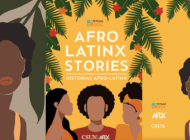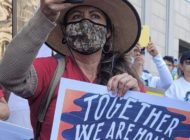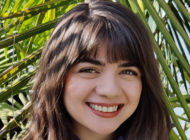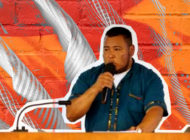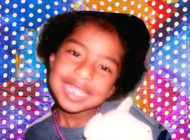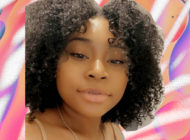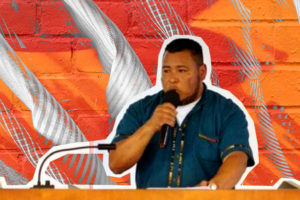In this episode, Melody Soto talks to award-winning poet and self-described MexiAfricana Natasha Carrizosa.
By MELODY SOTO
EL NUEVO SOL
Melody Soto: Welcome to Radio Nepantla, a podcast from El Nuevo Sol, the multimedia site for the Spanish-language journalism program at California State University, Northridge. My name is Melody Soto.
This series is titled Afro-Latinx. We want to tell diverse stories of the Afro-Latinx, Black-Latinx, and Afro-Latin American identity.
According to the Pew Hispanic Center, one out of every four Latinos in the nation identify as Afro-Latinx. This statistic also reflects the population of Afro-descendent peoples in Latin America.
We decided to use the term Afro-Latinx—with X—to be inclusive of non-binary people. The umbrella term “Black-Latinx” refers to biracial people with one African-American and one Latinx parent. The umbrella term “Afro-Latin American” refers to people of African ancestry in Latin America.
In this episode, meet Natasha Carrizosa.
Natasha Carrizosa: “But I wasn’t Black enough for the Black kids—and I wasn’t Mexican enough for the Mexican kids. So, growing up both Black and Brown was difficult to navigate—not to mention being raised on the Southside of Fort Worth, being poor, sometimes getting groceries from the church. There was struggle and there was poverty—and back then, I didn’t know that I was writing my way out of some of these things.”
Melody Soto: Her friends call her Natty, an acronym for “Natural And True To Yourself.” Natasha Carrizosa—an award-winning poet, creative writing instructor, published author, and spoken word artist, discovered the immense power words can possess in elementary school.
Natasha Carrizosa: “Poetry is how I began, or what I consider to be in my blood, or who I am. I am a poet first. All of the spaces that I go into begin with the word.
I wrote the first poem ever when I was in 5th grade. There was this little güerita—little white girl—in my class named Amy who wrote a limerick. And I said to myself: ‘I want to do that.’ I remember thinking: ‘If she can do it, I can do it.’ So, I wrote this poem about friends because I didn’t have any—and I literally ran home. I was so excited about what I wrote. And I told my mom: ‘Momma, I wrote a poem.’ She was in the kitchen, and she said: ‘Your father writes poems.’ And I said: ‘Daddy writes poems? Daddy is a roofer. Daddy can barely speak English. Daddy writes poems?’ And she said: ‘No—your real father.’
(I) didn’t have a relationship with my real father. I knew he had the same last name as me, ‘Carrizosa.’ I knew he lived in the same city as me. But that was probably the first time that maybe I heard of another poet—and I don’t think I’ve ever said that. But it intrigued me. So, I started writing—and I just kept writing.”
Melody Soto: Born in Texas to an African-American mother and a Mexican father, the creative writer has spent decades exploring her self-described MexiAfricana identity in her work.
The poem “3600 Block of Willing” paints a vivid picture of the multicultural upbringing she and her brothers—Gordo, Pana, Pelos and Isaac—were exposed to.
In the kitchen, Natasha often played the role of sous-chef while her mother recreated vibrant recipes, and an eclectic mix of music—from classical to rock and salsa—blasted in the background.
Natasha Carrizosa: “3600 Block of Willing is not written down anywhere, even though I thought it was—and I think I like it like that. The first time we got a house—or moved into a house—I was a junior in high school. And it was this little white house—the address was 3636 Willing. And when I sat down to write this poem, I thought about the numbers and the words and what that house still means to me.”
Melody Soto: The commencement of elementary school signified another pivotal moment in Natasha’s life. It was during this period that she began to perceive that her own hair texture and skin color were noticeably different from those of others around her. Within a segregated neighborhood, composed of primarily Black and Brown communities, Natasha felt that she didn’t fit into any particular group.
Natasha Carrizosa: “My best friend and my tia—my everything—is Hadji. Her name is Angela. I’m four years younger than Hadji. We were raised like that. So, when I started school I was living with my grandmother Florene—my Black grandmother. I first probably knew it with how my grandmother combed our hair, or brushed our hair, for school the next day. She would brush Hadji’s hair and put it up, and then I wanted to be like Hadji. And she did my hair, but when I woke up the next morning, it didn’t look the same.
And then when I went to school, and my mother dropped me off, I cried because none of the kids looked like me—and I was scared. As long as I was home I was safe, but when I was out, it was different.”
Melody Soto: But feeling out of place, only intensified for Natasha because insults and racist remarks from classmates became constant. And as her poetry chronicles, the bullying she encountered marked her entire grade school experience.
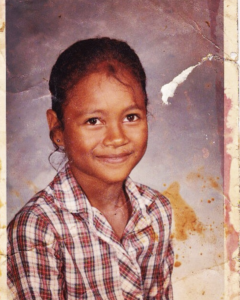 Natasha Carrizosa: “I remember I had a crush on this Brown boy named George, and we were running in front of De Zavala Elementary School, and he calls me the N-word. And I think by that time I was in third grade—but at the same school.
Natasha Carrizosa: “I remember I had a crush on this Brown boy named George, and we were running in front of De Zavala Elementary School, and he calls me the N-word. And I think by that time I was in third grade—but at the same school.
And I don’t know how to react to that. I don’t know how to react to that. And I just stop and I say: ‘I’m Mexican, too!’ And then there’s this kind of unknown shame (that) washed over me. That’s when I was made to feel different. And then middle school had its same. And then high school had its same.
I had a lot of different experiences that I just tried to, you know, swallow.”
Melody Soto: Scan through the volume of Natasha’s written works and it won’t be difficult to discern that the poet frequently alludes or makes direct references to her late mother. Born in Arizona, Elaine Duran learned Spanish as a child and taught Natasha’s biological father and adoptive dad how to navigate the English language. Natasha credits her mother—her muse and defender—with fostering an environment where she could embrace her multilayered roots.
Natasha Carrizosa: “My mother is everything—everything. My mother left the Earth some years ago. Fierce protector of me and my brothers. I don’t even say my mom is a lioness—my mom is a lion.
She was there when they would be speaking Spanish in the grocery store talking about this Black woman and these kids, and she would respond with fire in Spanish. And I witnessed that.
And I saw her with her students. And I saw her being a mother, and wife, and sister, and daughter. She is my blueprint—then and now.
There are times when I feel lost, but I just remember. She would say all the time, the best thing about her was me. I’m her only daughter—and I threw that in a poem, too. But yeah, she’s ever present. And a force. And the first thing that I wanted to say is she is God—to me.”
Melody Soto: Numerous childhood experiences have left a lasting imprint on Natasha, but the multifaceted creative contemplates on two particular occurrences often.
Natasha Carrizosa: “There are many moments that got to me.
One, one moment that I can’t erase from my mind—and Imma try to divide myself—I was like (in) kindergarten, right after, you know, going to school and figuring out that I was different, or my family was different. And we had just got this brand-new color TV. My mom was ironing and was watching Roots by Aldous Huxley. I don’t know if you’re familiar with that movie, but there’s a scene in there where the White slave master is beating this slave named Kunta Kinte. And he is beating him until he submits and says his name is Toby—this is what he wants to happen. Well, when he finally says Toby, my mom takes the iron and she throws it into the brand-new color TV. And I’m sitting there wondering—in shock. And that’s all I remember. But as I grew—and as I grow—I understand.
The other part was—I’m in high school, and I don’t have a tribe. I’m in the foyer of this school, and all of the groups are together—popular Black kids that I really wanted to be with, Mexican kids that I really wanted to be with. Rich White kids not so much. Anyway, school is about to start, and everybody is there, and this girl calls me a pepperbelly—(a) Black girl (who) looks like me calls me a pepperbelly. And everybody laughs. And (there’s) more laughing, and joking.
I don’t know what the word means. I just know what it made me feel—and it made me feel like that hot iron in the TV. It made me hot in the face; it made me enraged.
Anyway, I go home and I ask my mom: ‘Mom what’s a pepperbelly?’ And she just goes back to the range: ‘Who called you that? Who called you that?’ And I didn’t tell her all of the stuff I was called growing up, but when that happened she was like: ‘Who called you that?’ And, I don’t even remember her explaining to me what it was—but I got it. I was (like): ‘Oh, that’s not good.’
This is what it made me think of. So, in the South, when you have C-H-I-L-E, that’s chile—like ‘child.’ But in Spanish, C-H-I-L-E is chile. So, I wrote this poem called Pepperbelly.
Melody Soto: Although trauma has caused deep wounds within Natasha, the artist recognized early on that tapping into her creativity to manifest her personal poems has aided with alleviating the pain. These days, she drafts many of her compositions on the back porch of her Houston home. She says she writes it all down to get it all out.
Natasha Carrizosa: “This back porch, it becomes my sacred space. And it opens some doors, and opens like a portal to examining everything about me, all parts of me—my mind, my spirit— everything. Even when I write now—and I’ve been all over the place—I’ve written a lot of things, performed (in) a lot of different places, but when I sit and write, it is always for me. It is always for me. I never think about: ‘How is this going to sound?’ or, ‘Will people get this?’ It has always been for me and it has changed my life, and I think changed the life of others.”
Melody Soto: The first poem Natasha performed for an audience is titled MexiAfricana. Natasha also identifies as a MexiAfricana. She says that an encounter with author Willie Perdomo sparked the realization that this term best represents her. Also one of her most popular poems, MexiAfricana, proudly commemorates her heritage.
Natasha Carrizosa: “Willie Perdomo, he had this poem called Nigger Reecan Blues in this book called Where a Nickel Costs a Dime. And when I read that book, I was like: ‘Wow, I haven’t seen English and Spanish, and culture and music, and rice and beans—not like, I haven’t seen that.’ And I reached out to him—you know, to tell him about his poem, and he said: ‘I’ve never met a MexiAfricana before.’ And it was then, I was like: ‘Oh, that’s what I am.’”
Melody Soto: As a creative writing teacher, Natasha often works with youth. As poetry has transformed her life, she wishes those that encounter her work to take one key message with them.
Natasha Carrizosa: “In healing myself, with words, maybe others will know they have the same power, too.
I just get messages from everybody—that might be trying to find their voice, or celebrate themselves, or define themselves for who they are. I tell them: ‘You don’t need me.’ They don’t need me—to write. They don’t need me. They just need the words.”
Melody Soto: Thanks for listening to Radio Nepantla—La Voz que Traspasa Fronteras. We invite you to listen to the rest of the Afrolatinx series, where we will tell you stories of the Afro-Latinx identity.
Listen to our podcast on your favorite platform. You can also check us out on our SoundCloud channel—ElNuevoSol—or our website: ElNuevoSol dot net.
This was a production of El Nuevo Sol—the multimedia project of the Spanish-language journalism program at Cal State University, Northridge.
This episode was produced and edited by Melody Soto.
Voiced by Melody Soto.
With music by the Afro-Colombian group Kombilesa Mi.
See you next time.
Tags: #AFLX Afro-Latinx Natasha Carrizosa podcast poet poeta Radio Nepantla








